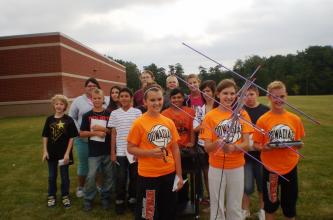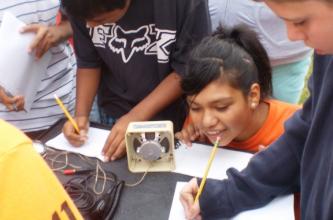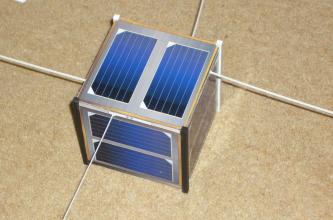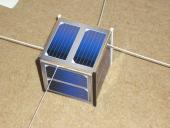-

Tracking ARISSat
Students at Dowagiac Middle School in Michigan prepare to track ARISSat to receive telemetry data. -

Listening to the Satellite Beacon
Students record telemetry from ARISSat. -

CSI Space: What's Going on With FUNCube?
What story does the data tell? Join the investigation!
Bringing Space into the Classroom
Bringing space into the classroom is an incredibly powerful learning experience for students. The marriage between wireless technology literacy and space literacy is a strong one that produces a portfolio of activities that can engage virtually all students at some ability and interest level.
The portfolio of activities can range from simply having a satellite prediction software package running in the back of the classroom on an old, salvaged computer, a simple receiver to collect telemetry data from orbiting satellites, to a full-up ground station to communicate with other hams via satellites, or even with the astronauts in the International Space Station through the ARISS (Amateur Radio on the International Space Station) program.
FUNCube
-
CubeSat Investigators: What's Going On with FUNCube?
 By: Mark Spencer, WA8SME mspencer@arrl.org
By: Mark Spencer, WA8SME mspencer@arrl.orgThe FUNCube (AO-73) satellite is an excellent resource that allows your students to be real space sleuths and hone their forensics skills by investigating what is happening to the satellite on orbit…just like the TV crime scene investigators do in the popular crime solving shows. The FUNCube (FC) satellite is a satellite that just keeps on giving and is full of surprises.
Suggestions on how to access the telemetry signals being transmitted by the FC and a description of the Materials Science Experiment that is carried on the FC are summarized in the Pragmatic Guide for Using the FUNCube (AO-73) Materials Science Experiment in the Classroom.
I have been monitoring the FC telemetry since it was first launched in November 2013, and some interesting inconsistencies between what I expected and what actually is happening on orbit became evident almost immediately. This resulted in my own CSI investigation to try and figure out what happened, what is happening, and what can we expect in the future with this satellite. This investigation included steps similar to those taken by a TV CSI team; secure the scene and collect data, evaluate the data to gain some perspective as to the who, what, where, how, and why surrounding the scene, scrutinize the data to develop theories, test those theories with the data that was collected, discredit, advance, adjust, and/or make new theories based on the investigation and the data, and hopefully discover that one scrap of evidence (data) that leads to the ah-ha moment that solves the mystery…or sometimes, leave us hanging with a mystery unsolved.
While evaluating the temperature data generated from the Materials Science Experiment, I also looked at the rotation rate of the satellite. Around December 28, 2013, something happened to the satellite that resulted in an abrupt and unexpected change in the rotation rate that warranted a second and more detailed look. The mystery continued from there.
The rotation rate slowed down to a minimum of about 8.5 minutes per revolution, then started to spool up again to the current (as of this writing) of about .92 minutes per revolution, but now there is a hint in the data that the spin rate is going to slow down again. So what is going on?
- The FC is basically a gyroscope that is spinning about its Z-axis. [Why do they want a satellite to spin?]
- There is no mechanism built into the satellite to impart and maintain a rate of spin. [Discovered by reviewing the available construction details of the satellite. Is this a good thing? What do other satellites use to impart and maintain rotation about the Z-axis?]
- What forces are there on orbit that would cause the satellite rotation rate to change? [Air resistance? Solar pressure? Micro-meteorites, dust, junk, etc that can collide with the satellite? Something else?]
- Is there a relationship between the rotation rate of the satellite and the temperatures of the Materials Science Experiment bars? [If there is a relationship, what is it? What would be the cause of this relationship? Are the bar temperatures the same or are they proportionally different? ]
It is up to your CSI team to come to their own conclusions. For me, I am looking at a couple of interesting theories, and learning a ton of things along the way.
First, there was an obscure reference in a scholarly document about gyroscope behavior (that unfortunately I can’t find again) that speculated, “If a precession force were applied for less than 1/4th the period of a gyroscope’s rotation, this precession force pulse might result in an increase in the rotation speed.” The fixed magnet within the satellite that is used to align the Z-axis of the satellite with the lines of the Earth’s magnetic field “flips” the satellite end-over-end twice during a single orbit. The magnet imparts a precession force that is perpendicular to the Z-axis to accomplish this maneuver. Could it be that at the low rotation rate, this flipping force is less than 1/4th the period of the slowest rate of rotation and therefore is imparting a small force that increases the rotation speed?
Second, there is a theory concerning the force mechanism that causes small asteroids (as small as 10 centimeters) to rotate. This theory is called the Yarkovsky-O’Keefe-Radzievski-Paddack Effect (YORP). Basically the YORP effect speculates that small temperature differences across the mass of an asteroid along with differences between the emissivity and absorptivity of the material that makes up the asteroid impart tiny forces that over time cause the body to rotate. The theory is that these tiny forces are due to the differences in pressure that result from differences the way that heat energy is absorbed and emitted from the surfaces of the asteroid. But it can take thousands of years between visits to Earth by an asteroids making the comparison of rotation rates from one pass to the next impossible. Could it be that the FC is a manmade object that is exhibiting the YORP Effect? Could it be that the FC will allow us to verify the YORP Effect?
The fascinating thing about all this is that no one really knows what is going on with FC? Your CSI team can come up with theories and speculations that are just as valid as anyone’s. And perhaps your CSI team might discover that ah-ha data moment that solves the mystery.
If you would like some additional details about my investigation, let me know. The participants in this year’s teachers institutes can expect the opportunities afforded by collecting and analyzing FC telemetry to be covered in more detail.
New Resources for Classroom Instruction
For an overview of recent addtiions of classroom resources designed to help teachers instruct students about research projects to be launched by AMSAT on its Fox satellites, view a video of a presentation by Mark Spencer, WA8SME at the 2013 AMSAT Symposium. Details of these resources are provided below.
Resources
-
This library is a collection of resources designed for teachers who want to explore satellite communications with students. There are also instructional resources designed for classroom exploration of satellite telemetry data used to understand satellite engineering and research deployed on satellites. The classroom resources are manipulatives that can prepare students to understand and utilize live telemetry data that can be captured from orbiting satellites.
Copyright. ARRL ETP resources are intended for educational purposes. When used for this purpose, please acknowledge ARRL as the source. Additional permission is required to use this material in any training or product that will be redistributed or used for re-sale. Learn More
-
Space Technology in Your Classroom
Here are some suggestions of ways to bring space into the classroom easily, effectively, and at little or no cost, and some illustrations of the standards and benchmarks are addressed.
Learn More -
Satellite Antenna Rotor Simulator
This article describes a satellite ground station antenna rotor simulator that you can use to demonstrate tracking a satellite as it traverses across the horizon during its travel in orbit. Accessing satellites (including the International Space Station) is a content rich activity that can enhance the classroom instruction of numerous content areas. This resource is intended to be part of the portfolio of space related activities that would be used to prepare for, and continue exploring space after, an ARISS contact (Amateur Radio in the International Space Station).
-
The CubeSat Simulator provides a way to demonstrate satellite fundamentals in a controlled and predictable way, right in the classroom. Read about the design and classroom applications envisioned by developer, Mark Spencer WA8SME.
Teachers who are interested in acquiring a CubeSat Simulator Kit for their classroom can apply to request one through an ARRL Education & Technology Program Progress Grant. When completing the grant application we will be looking for the following information and commitment:
(1) The lead teacher will need to explain how he/she plans to use the CubeSat simulator in his/her classroom curriculum, and
( 2) The lead teacher must be willing to share some curriculum ideas she/he develops employing the CubeSat to contribute to a library of shared resources that will be available to other teachers.
Information about ARRL Education & Technology Program grants can be found at: www.arrl.org/ETP-grants
-
Study Satellite "Wobble" Using Telemetry Data
The Attitude Determination Experiment Simulator is a classroom resource designed for use in 8th-16th grade classrooms to allow students to simulate the actual experiment being launched on the Fox 1A satellite. This is an attitude experiment based on a 3-axis, microelectro-mechanical gyroscope. The experiment data measures the performance of the satellite’s magnetic stabilization system. From experience gained with the simulator, students will be able to make the connection between the actual telemetry gyro data reported by the satellite on orbit to the rotational behavior of the satellite. If there is some unexplained data collected, it is hoped that the students could configure their simulator in such a way as to replicate the data and visualize the tilt, rotation rate, and wobble that is happening in space.
-
Managing Satellite Power: A Study in Maximum Power Point Tracking
How can the power generated by solar panels on a satellite be managed and used most efficiently? Use this classroom resource to engage students in a research project that attempts to answer this question. The Maximum Power Point Tracking (MPPT) system that will be deployed on the Fox 2 satellite is replicated in this classroom resource to enable students to simulate the experiment and the variables that will be studied by capturing telemetry data from the orbiting satellite. Students will be prepared to study and use live data when the experiment is launched.
-
MAREA is a Mars Lander/ Marine Amateur Radio Robotics Exploration Activity.
The MAREA program is an actvity that involves programming robots to respond to commands sent long distance by packet radio. It employs a UHF radio tranceiver designed for local communication with the robot. To simulate how space research is done, students can send commands to control robots via the ISS packet station.
Learn More -
Using FUNcube to do Materials Science in the Classroom
A Materials Science Experiment launched on the FUNcube Satellite developed by AMSAT-UK is designed so students can capture data transmitted from the satellite to exxamine how heat energy is radiated into space from materials with different surface finishes.
A teachers guide developed by Mark Spencer with ARRL's Education & Technology Program explains the experiment, the data that is transmitted and how teachers can apply the data to laws of thermodynamics. Included is a description of a Leslie's Cube experiment that can be conducted in the classroom to help students understand the concepts that can be explored with the data transmitted from space.
This article provides an overview of the FUNcube experiment and the purpose of the Guide.
-
The following videos illustrate satellite rotation and provide instructions to make a classroom resource to demonstrate this rotation with students. CubeSats are rotating about their Z-axis for thermal and gyroscopic stability. They also use fixed, permanent magnets installed in the satellites with the poles of the magnets aligned with the Z-axis. The magnets cause the Z-axis of the satellite to tend to align with the lines of the Earth’s magnetosphere to keep the satellite antennas properly oriented to facilitate communications with Earth bound satellite ground stations. This simple PowerPoint animation illustrates the Z-axis “flip”. Simply view the PPT to run the simulation.
Flip animation: Click here to view
A simple classroom manipulative made from cylinder magnets and a CD-ROM jewel case. The manipulative demonstrates the Z-axis flip maneuver in the classroom. This short video clip shows Z-axis flip manipulative in action and how it is made. Manual Orientation demonstrator video: Click here to view the video
With the CubeSats rotating about the Z-axis, they actually behave like a gyroscope. One phenomena of the angular momentum of a spinning gyroscope is precession. Precession is a reaction to a force that is applied perpendicular to the axis of rotation of a gyroscope. These precession forces tend to counter act the applied forces to keep the gyroscope orientation stable. When a CubeSat undergoes the flip maneuver, precession forces are applicable and could cause the cubesat to wobble about its Z-axis. This short video shows what happens when forces are applied perpendicular to the spin axis of the gyroscope. This might help visualize the forces experienced by a spinning CubeSat on-orbit.
Gyroscope effect video: Click here to view the video
Equipment
-
Resources for Satellite Operations
In the interest of supporting teachers who want to bring space into the classroom by acitvely engageing students with amateur radio satelltie communications, the Education Technology Program has developed some equipment resources designed with utility to support ham radio satellite operation for classroom use.
-
The following articles describe how to build an interface and satellite tracking antenna. Related articles;
- Satellite Antenna and Tracking Interface article written by former ARRL ETP Coordinator, Mark Spencer, WA8SME
- ARISS Antenna and Satellite Tracker Interface, also by Mark Spencer. This equipment configuration was designed specifically with school station contacts with the ISS in mind.
- ARRL articles about Satellite and Space communications
-
ETP Director, Mark Spencer, WA8SME developed a minimalist station antenna to monitor ISS packet activity in the event that someday the ISS has frequent SSTV activity, or might transmit some student experiment data down a 2 meter pipeline. With this minimalist station a school should be able to set it up and let it run unattended, return and check for updated data as time and lesson activity permits.
Learn More -
ISS Minimalist Antenna, UHF Version
When the ISS operates packet on UHF frequencies, you will need to obtain an appropirate UHF antenna. This article describes a scaled version of the minimalist turn-style antenna that you might want to try. One word of caution though, due to the physics of wave propagation, don’t expect to get the same results as when the system is operating on the 2-meter band, the reason is briefly described at the end of the article.
Learn More -
Inexpensive Broadband Preamp for Satellite Work
A preamp is important for quality satellite contacts. This article describes a preamp design that is inexpensive and makes the difference between hearing noise and establishing contact. This pre-amp is available assembled and for purchase from the AMSAT store.
-
Inexpensive “WRAPS” Rotor for Satellite Work
The WRAPS (Wobbler RadFxSat Antenna Pointing System) rotator system is designed to support tracking the CubeSats. It is a portable, battery operated satellite antenna rotator system that can be easily duplicated using commercial, off-the-shelf (COTS) parts, and by using simple hand tools with a minimum of machine work. This rotator system should be an affordable alternative to the industry standard that will help make setting up a ground station for schools.
Licensing, Education & Training >> Amateur Radio in the Classroom >> ETP Classroom Resources >> Classroom Library: Satellite Communications





